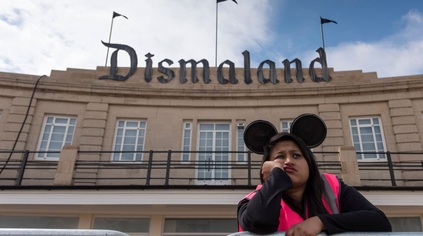 I first visited the Tropicana on a school trip - probably sometime in the late 1980s. I wasn't a swimmer, so joining a small number of sick, limping or otherwise unpopular kids, I skulked around the margins of the site. There was a model railway, a café, and plenty of space to sit and ponder how much more fun the other kids were having in the pool. Even then there was a sense of gloom about the place: beyond the huge fibreglass pineapple that dominated the site - and which gave it perhaps it's only truly 'tropical' credentials - the plaster was already peeling, the colourful murals of palm trees and blue skies flaking under the pressure of a spending crunch. After an interminable day that was perhaps remarkable only because it didn't involve being in school, I was glad to leave the place. It is miraculous that it struggled on as long as it did after this, finally closing its doors in 2000, outdated and outpaced by tastes and time. Left behind - a portent of things to come for Weston-super-Mare perhaps?
I first visited the Tropicana on a school trip - probably sometime in the late 1980s. I wasn't a swimmer, so joining a small number of sick, limping or otherwise unpopular kids, I skulked around the margins of the site. There was a model railway, a café, and plenty of space to sit and ponder how much more fun the other kids were having in the pool. Even then there was a sense of gloom about the place: beyond the huge fibreglass pineapple that dominated the site - and which gave it perhaps it's only truly 'tropical' credentials - the plaster was already peeling, the colourful murals of palm trees and blue skies flaking under the pressure of a spending crunch. After an interminable day that was perhaps remarkable only because it didn't involve being in school, I was glad to leave the place. It is miraculous that it struggled on as long as it did after this, finally closing its doors in 2000, outdated and outpaced by tastes and time. Left behind - a portent of things to come for Weston-super-Mare perhaps?
However, as the last fifteen years have proved, the Tropicana is privileged space. It occupies a slot in countless thousands of memories. It has figured in the summer holidays of locals and visitors alike - and thus it is recalled in that special way that childhood summers always are. It never rains, the colours are brighter than reality, the days longer, food tastier. These memories have been trampled by the steel toecaps of reality for long enough for the site to be almost mythical, and for a town prone to almost terminal apathy, the public can be easily roused by even a perceived threat to the hallowed quadrant on the sea front. For years though, it has only truly existed on the pages of Council Executive reports and architects drawings. The site has variously sprouted huge hotels, cinemas, towers of housing. Always with those shadowy sketch-people milling around them which proxy for reality in these artist's impressions. Developers have come and gone. Opportunistic local bruisers have tried to make political capital from the ruin, while simultaneously proposing to raid the public coffers. Eventually we reached the point of no return - the Tropicana was to be demolished. It felt like a necessary exorcism. But still it is attached, decaying and prone to infection. Weston's ever-grumbling appendix.
The reaction to Dismaland has been both entirely surprising and utterly predictable. The surprise has largely centred on the miracle that this most scrutinised and picked-over of sites could be transformed so completely yet so secretly before us in plain sight of the town. Indeed, that the much-maligned Council could have allowed - sponsored even - something of this nature has bewildered people. Their normal knee-jerk reactions stopped in mid-ascent towards the collective groin of the elected members. The - entirely accurate - story that only four people in the organisation knew the whole truth is equally astounding in the leaky rumour-mill of the Town Hall. But there are more predictable voices at large - many rehearsing the bizarre belief that the Council is stupid enough not to see the double-edged swordplay it indulges in by inviting an event called "Dismaland" onto its prized promenade - indeed onto this most sensitive of local sites. Rolling eyes and folding arms, they tell me that the event will pass into history with the momentum not seized. That it's all a bit rubbish because they don't get 'art' anyway - and probably wouldn't get tickets if they tried. After all, Weston is a bit crap, right? For a few days, this low-pitched drone has surrounded the place, cloaking it in the very miasma of gloom that the curator is trying to foster. If anyone has been gamed, it's these very doubters who are now playing a key part in the set-piece on the seafront.
I've written and talked a lot about the seaside resort problem - and on one of its many levels, Dismaland taps right into this. It reminds me of a family I saw tumbling out of an Eastbourne café one Saturday morning a few years ago. As they picked the stringy bacon fronds from their teeth they summed up the issue in a single question: "What the fuck are we going to do until dinnertime?". The disappointing attraction, the underwhelming spectacle and the hours of time killed between cheap food and beer binges are summed up in the premise behind Banksy's installation. The venue is also perfect. Seaside towns are different from 'towns by the sea': they've chosen not to change and have resolutely stayed on rails laid in the late 19th century. The family seaside holiday of guest houses, fish and chips and beach-hogging is the preserve of a now itself nearly mythical working class. Fortunes dwindle, buildings peel, capital retreats - and now these towns regularly appear at the top of child poverty ratings and unemployment figures, suffer disproportionately from addiction and crime and oddly rank highly in their negative responses to immigration despite being some of the most resolutely white parts of the nation. That fear of the incomer, that disparaging view of those who arrive in town - the tendency to bite the hand of the 'grockles' that feed them is burned deep into Weston and it's natives. They are about to suffer the biggest influx of incomers for many, many years - it's going to be entertaining to watch.
The other equally gloomy if somewhat quieter voices are those from neighbouring towns, decrying the desperation which leads a place to accept Dismaland as its defining moment. There is a touch of green around their gills for sure - it's a ludicrously good coup, and a glance at the economic benefits from Banksy's Bristol exhibition a few years back rightly makes them seethe with jealous rage. Their prime concern is the town's brand - how it can recover from this shock to its system without suffering the sting in the tail of the term "dismal"? But they miss a point here - the town simply doesn't have a brand. It's one of those reforgotten resorts which has been at this crossroads for years - Stag venue? Retail centre? Dormitory town? The options are unedifying at best - but this offers an alternative. As the world was griping about the ticketing website failing and the early-invitees smugly sharing their pictures of the site yesterday, the Chief Executive of North Somerset Council was changing tack - pop-up shops in town would be encouraged, creative events and industries promoted. This is tremendously significant - the received wisdom before was that if we wanted to attract big High Street names, it was always better to have an empty shop in town than some scruffy little independent cluttering up the place. The truth is perhaps the opposite: another Poundland or charity shop is a much bigger disincentive, while the major chains watch successful independents like vultures waiting to swoop. Let them do the hard work before we arrive. There is finally a bit of coherence to the vision for the town. It remains to be seen if it plays out as they hope - but I think the textbook regeneration doom-mongers are a little more spooked than they admit.
I've yet to visit Dismaland - but I'm excited to have this opportunity on my doorstep. Quite apart from the playful, irreverent fun of the pieces Banksy has assembled, the sense of an event and the sheer oddness of revisiting a childhood haunt transformed completely, there is a more substantial edge to this. The exhibits play into the concerns we should all have about our public spaces - privatisation of access, spiralling security measures, domination by faceless brands and franchises. I'm also excited by the debate that seems to be emerging: the ideas about what local government is for, what public spaces should host, and what kind of vision we should develop for that most difficult of places - a fading seaside resort on a muddy estuarial reach. I hope too that in time, the doubters are at least quieted by the success of this enterprise - but I know they won't be. After all their lemon-sucking cynicism and their desperate clinging to irony is as much part of the show as the crumbling Disney castle silhouette.
Crossing London can be a trial at the best of times, but today offered some special challenges. I knew in advance that various parts of the Underground network were out of action, but my early luck in tumbling onto a replacement bus service lured me into thinking this might well be simpler than I'd hoped. The bus lurched around a couple of corners from Paddington, rather suddenly depositing us in a back street which the driver claimed was Baker Street. It wasn't by any stretch - but a brisk walk, down into the station and finally onto a Metropolitan Line train for Aldgate - and I felt pretty smug. I was beating the city at its own game. Another quick walk to Tower Gateway and onto the DLR platform - a train was waiting silently for departure, so I made the walk down to the front to get the best view. As we meandered between landmarks from my previous excursions, I thought about my next move. I could, very reasonably, choose to use the cable car to traverse the river on this occasion - it would deposit me exactly where I wanted to start and afford me some interesting views. But for some reason, I decided that it could wait for another day and foolishly I bailed out at Canning Town. As I descended the stairs and saw platforms taped off I remembered that this part of the Jubilee Line was closed too. I turned and fought my way back up to the platform through a throng of disgruntled travellers. Perhaps this wasn't going to be so simple after all... As I waited for a Woolwich bound train I pondered how my early start had been squandered, how my intense fear of escalators could elongate an already epic journey, and finally how London had a treacherous habit of confounding those who dared to claim they knew the city even passably well.
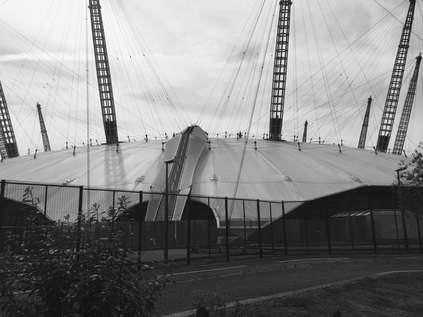
I finally rolled up to North Greenwich Bus Station a good deal later than planned, and desperately requiring coffee. In fairness the crossing of the city, once I'd given in to its circuitous nature, had been interesting. A pleasant arc across the rooftops of Silvertown and North Woolwich, then a bus ride through territory I'd walked on the south bank a month ago, mostly strangely indistinct and suburban. I knew we were close when Bugsby's Way made a dip under the railway lines to Angerstein Wharf and the now abandoned eco-Sainsbury's store appeared. Stepping out of the bus station, I ventured towards the Dome - I'd avoided it last time, when I felt deeply out of place here. I didn't feel any more comfortable this time - but I was less ragged and sunbaked, and there were far fewer people around this morning. Spying a familiar coffee vendor's logo I ventured inside the building, to find that the store was being refurbished to "improve my O2 experience". I left and found a rival chain, busier than it deserved because it appeared to be the only coffee on the Peninsula. After another interminable delay I decided to drink and walk. There was no more time to waste at this millennial folly. It had already drawn me into spending longer than I could spare on it. I struck out for the river, finding the path just a few metres from where I'd turned aside a month ago. The river shimmered under cloudy skies, the marine breeze tempering the heat of an already strong sun. On the path, Gary Hume's "Liberty Grip" gave the finger to the dome - a huge bronze casting based on store mannequin parts, This is a part of an impressive exhibition - The Line - which brings public art out into the Lea Valley, The Royal Docks and the Greenwich Peninsula. I'd missed the publicity for the opening back in June, but have oddly found myself stumbling around the route between the artworks almost instinctively. Indeed, it's only a short walk from Hume's work to the second, far more unassuming piece - Thompson & Craighead's "Here" sits in the middle of the pathway, a regulation British road sign pointing out into the river, roughly on the Prime Meridian. The destination? Here. The distance? All the way. While I enjoy the conceit, I'm soberly reminded of Iain Sinclair's words:
An involuntary return to the point of departure is, without doubt, the most disturbing of all journeys
Rounding the curve of the peninsula, the views across the river provide a new take on old haunts - the diamond-paned lighthouse at Trinity Buoy Wharf gleams in the late morning sunshine, while behind it the bigger expanses of City Island's red hoardings reflect nothing. It's possible - almost - to ignore the gravity of the Dome here, as the tangled skyline of the Isle of Dogs draws the attention. Across the water in Blackwall I see the flapping stars and stripes on Virginia Quay, and somehow this makes the city skyline seem entirely elsewhere - an unexpected transatlantic transport from an area rich in such escapes over the years. I press on, turning south, the tradesmen's view of the Dome evident. Delivery hatches, cooking smells, containers lined up and marked with the names of food concessions. The path deviates a little from the river here, slipping around an unfinished building site and skirting the edge of the Blackwall Tunnel Approach Road, the red stone gauging arch sitting proudly in the expanse of flat former marshland, like a fragment of transported Glasgow tenement. Pushing through a narrow section of path and challenged by frustrated cyclists, I emerge at Victoria Deep Water Terminal - a place designed apparently to test my nerve and my prejudices. Firstly - it looks like I can't pass. I am so conditioned to expect exclusion and prohibition, that I can't imagine that the way through this desert of aggregate dust and swinging crane jaws can seriously be a footpath. There is also an alternative route marked for cyclists, and I wonder if I'm condemned to fight my way through them instead, but unexpectedly the hard-hatted inhabitant of a small safety station motioned me forward and gave a signal to the crane driver. I approached and hugged the fence while the empty jaws of his bucket wheeled overhead. As he dropped them into the hull of the ship he called me forward. I tried to calmly pass by as I felt the bucket raising again behind me. My trials weren't over - a smaller machine was shifting a pile of dusty grit across the path with a much lower derrick - again I was called on, offered effusive but mute thanks with a hand gesture and hurried under. As soon as I dared, I turned and snapped a picture of the wharf in literal full swing, the towers of Docklands behind them. Like a tiny history of British industry in the last century. Meanwhile, across the river the Isle of Dogs was broadening into perhaps the most famous river bend on TV, leaving its towers and financial centres behind in favour of low-rise housing, slum-clearance estates and the occasional prefabricated block. From here it was hard to conceive of how the area had figured so readily in recent history - newspaper disputes, fascist councillors, insider trading all seemed unlikely headlines when reflected on the quiet red-brick waterfront dwellings with their little post-modernist flourishes and nautical round windows. The path here was unexpectedly secluded, trees overhanging the riverfront, abandoned jetties rotting in the water, framed views of the other bank between fronds of water-loving foliage. Looking ahead, the western turn in the river provided views of where I was heading: the hulk of abandoned power station at Greenwich dwarfing the grandeur of the Royal Naval College.
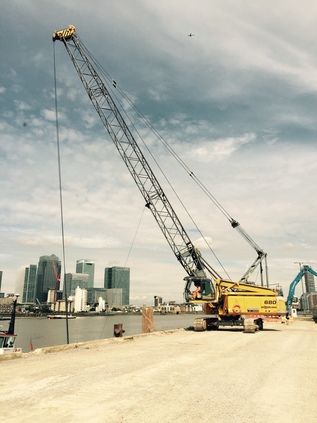
In fact the walk towards Greenwich instilled a false sense of security. The river path is quiet, sometimes feeling almost rural in aspect. The developments which encroach on the path are well-intentioned if sometimes clumsily executed attempts to fit the area's provenance. There's no doubt that Greenwich recognises the importance of the Thames to the borough, even perhaps cultivates its myths. There is permitted dereliction. Piers quietly decay behind 'Danger' signs, remnants of older industrial uses when we were less sentimental about - or perhaps less aware of the equity in - the river front. Suddenly, the scene shifts, from the tangle of buildings around the bulky power station, the hospital building emerges - a squat, white plastered tower built in 1616 and decorated in vivid red and gold. The gardens are prim and pristine, the path stepping up to the tower ornamentally. Looking ahead, the river path is narrowed and hemmed in by the railings which surround the Royal Naval College - there are suddenly people everywhere, enjoying the gasps of sunshine between ominously long cloud breaths. I deviated briefly into the College grounds for a picture, remembering being here years back, at a summer conference. I was in awe of the buildings then, amazed at this rather prosaic, educational use of protected heritage assets - but approaching from the river, it's easier to see how this fits into the tourist trail - Maritime Greenwich, home of time and place, centre of the historical universe. I wait for an unobstructed shot across the perfectly cropped quad between the blocks, the distant view into the park signalling a walk not yet attempted. Indeed this view could have been entirely different if Flaxman's Brittania had been built. Our very own Statue of Liberty could have dominated the view here. It is simply not worth returning to the river here - the crowds blocking the narrow strip of path unclaimed by the College are sluggish, stopping for frequent selfies against the fence. Instead I cut across the grass, passing the Meantime Brewery and out on the plaza surrounding the Cutty Sark. Since I last visited this vessel has completed a phoenix-like cycle: both burned and risen again, with the area around it turned into an amphitheatre of naval history. A Saturday market is in full swing, the school holiday crowds fully exploited by local artisan food huts and coffee vendors while a string quartet plays in a tent. After deviating briefly to get supplies I grab an overpriced coffee and take a seat a little way from the action. Across the river, Island Gardens nestles between the towers of the Isle of Dogs. I remember similar rest stops there many years ago. It looks quiet and cool - the grass most assuredly greener in fact, and I feel a pang of regret for being this side of the river. It will pass, its just the consequence of this tide of people intruding on my usually solitary, utterly selfish walks.
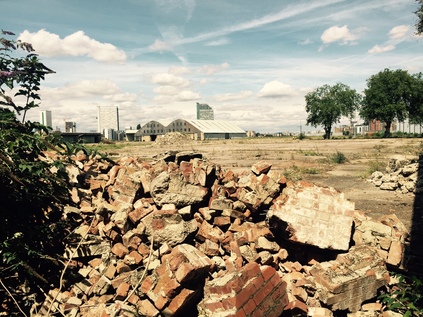
Leaving Greenwich by the river path is a new experience, and improves on the usual route: there was always a sense of disappointment as the perfect heritage-groomed town centre gave way to sprawling suburbia on route to the station. But the Thames Path feels more honest - leaving Greenwich means entering Deptford. First though, the disadvantages of travelling with ancient maps are made apparent. I expect a dog-leg via Creek Road to cross the mouth of Deptford Creek, but instead find a shiny, modern footbridge spanning the water where it meets the Thames. It appears to be part of the planning gain from a new development - Greenfell Mansions - which flanks the river on the western side, a stack of apartments topping a nearly-empty café and hairdresser. A glance back down the creek as it turns back east is equally uninspiring, skirting more modern, anodyne blocks before the road bridge. Below footpath level the steep sided channel is sluggish and brown, a remnant of its industrial past and remarkably a conservation area, though little of historical note remains. The real ruins are further along the Creek - here it's all about exploiting the river front. Soon after crossing the Creek it's necessary to turn aside from the Thames briefly as the path is broken where the Borough of Greenwich begins to peter out. Forced to edge around an electricity substation, I realise that I'm about to pass into Lewisham and wonder how the boundary will be marked? I soon find out at the corner of the improbably named Twinkle Park - no signs or ceremony, just a pile of steaming dog shit strewn haphazardly across the path and impossible to avoid. I slide ridiculously in the ordure, grabbing a railing and checking to see just how much dignity I've lost. I'm alone luckily, scraping a boot pointlessly on the dry ground. Welcome to Lewisham, and time to find some grass to clean my boots. However, there's little foliage to exploit as the vast Convoy Wharf, formerly the Royal Dockyard, interrupts the river path. The site is now an endlessly flat plain of cement with the vast hangar of the Olympia Warehouse describing a dark sine wave on the view towards the Thames. The large and irregularly shaped site soon gives way onto the street, and I poke my camera through a railing just feet from a security cabin with no apparent response. It's abandoned, quiet and dusty, the archaeologists have left after digging for history as a planning condition. The site belongs to News International - an artefact of an urgent acquisition of various large off-city plots of land for Murdoch's union-busting masterplan which eventually saw his fortress land over the water in Wapping. After trudging miserably through a low-rise, litter strewn municipal estate I make for green space as a priority. Firstly, I stumble into Sayes Court Park - an unprepossessing, unkempt square of yellow, parched grass which once housed John Evelyn's house, and which is linked to the nearby dockyard by historical association. Land deals and wartime appropriations have left this space for the people, a central formal garden listlessly trying to leverage the antiquity of the site. Next is Pepys Park - dedicated to the other local diarist who worked in the Royal Dockyards when not busily exploiting his patronage elsewhere in the city. The park serves - and indeed shares a name with - a important post-war housing development which I barely even note today aside from its remaining highrise block, Aragon Tower, leering over the path. Life here has been surprisingly well documented because of the approach taken to replacing the former industrial slums which served the dock workers - and its perhaps not unexpected decline. The park is remarkably quiet and unexpectedly capacious. I cross the flat playing fields, before plunging into a wilder, stepped area given over to wildlife. From the second floor of a building on the edge of the park, a parent is unfurling a hose pipe to fill a children's paddling pool on the park edge. It's good to see people using this space, living in it, not feeling constrained by rules or practicalities. The artificial gardens of Greenwich seem a long way off here. The park climbs back towards the river path and Deptford Strand, where in 1593 Christopher Marlow was allegedly killed in an drunken brawl at Eleanor Bull's home. The most notorious unsolved murders in London seem always to come from north of the river, but this one remains a deeply suspect case and by modern accounts seems more of an assassination with Marlow punished for his "epicurism and atheism". The Strand now is a quiet, private space, free of conspiracies with the wine warehouses and the Victualling Yard converted into pleasant, if expensive dwellings to front the right-to-buy paradise.
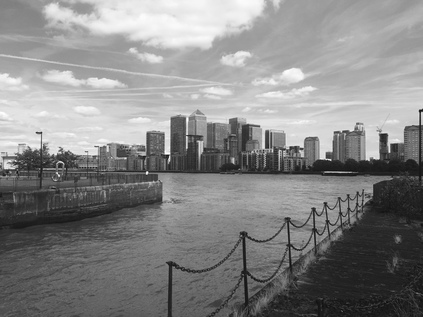
Turning north to follow the dramatic curve of the river, I cross the mouth of Greenland Dock by way of a climb up the boards of the arched Victorian footbridge in preference to the modern roadway, This is the southernmost remnant of the Surrey Commercial Docks which once riddled this bulge of land with waterways, clustering around the Grand Surrey Canal. All the signs direct me to Surrey Quays or Rotherhithe stations - the assumption is I don't want to be here and the assertion is to leave swiftly. Indeed, there is little of note on this odd peninsula, and the low rooftops which have crept relentlessly over the in-filled docklands are strangely suburban in nature. Everywhere the eye is drawn to the north bank, to Limehouse Church, or east to the ever-brooding towers on the Isle of Dogs. A distant parade of No. 277 buses wink in the sunlight as they amble around Westferry Circus, running empty on a weekend afternoon. Suddenly I'm alerted by the unexpectedly rural sounds of sheep, as I find the path delving into the fringe of Surrey Docks City Farm. I'm tempted to wait time here, find a bathroom and a place for refreshment in this oddly charming little nook, but time is pressing and with the compromised transport options and being urged to wash my hands to prevent transmission of animal diseases, I feel the need to press on. I make a note to revisit though, as I know these sheep would be popular with others back home! The path is interrupted again, this time by a confusing Doubletree Hilton Hotel, sprawling across several buildings with unclear rights of access to the river. A token ferry service runs - often empty - across to Canary Wharf Pier apparently just to allow the hotel chain to claim its Docklands provenance. The service is sponsored by Transport for London - a little known, little used crossing, funding justified by the apparent importance of plugging a gap in the infrastructure between Tower Bridge and Woolwich. Reaching the tip of the Rotherhithe peninsula, I cross a stymied and sluggish inlet which disappears into a string of ecological parks in the centre of the former docks. The riverfront road is called Sovereign Crescent here - a nod to the former King and Queen Wharf in name only - nothing is left here of the past. In fact nothing gives a clue to the former nature of this area for some considerable distance, until the rotunda housing Brunel's Thames Tunnel portal appears a little inland and reminds me of a brief walk here when I was exploring the old East London Line. Further inland still there is a historic district to explore, with unexpected links to Scandinavia - but not today, I'm sticking to the river out of bloody-mindedness. I've almost reached my target. Footsore and surprisingly sun-reddened giving the earlier gloom, I detect a change in the fortunes of the area - in typical London style I have made the unannounced switch into a new locale. This is Bermondsey. Where Rotherhithe and Deptford have largely turned their back on the river, Bermondsey was an early adherent to the cult of gentrification. The situation is perfect - close enough to the City to benefit from rising rents, but south of the river - so out of the pernicious grasp of the Corporation. As industry retreated from London and the wharves closed, so the great docks on the north bank were levelled and left as desolate film sets for apocalyptic epics. Here though, there was a swifter turnover. The first loft conversions east of Brooklyn arrived before Docklands had left the drawing board. The narrow streets still wind between tall brick warehouses, bridges still cross haphazardly between them, sometimes dripping with foliage. It's dark, redolent of the river, the reek of Dickens' prose hanging heavy about the streets. Approaching the end of my walk I'm undecided - I know of many interesting landmarks I'd like to find deeper into Bermondsey, but the river is the focus and I feel compelled to stay with it to the planned point of departure. I make a short diversion along Mill Street to take in New Concordia Wharf with its towering chimney and retro-painted gateway, before plunging into a gap between buildings to reach the narrow footbridge over the River Neckinger at its confluence with the Thames. The path is busy with well-dressed people shuttling between the waterfront restaurants near Tower Bridge and the up and coming Bermondsey boutiques. A dusty river-walker is not required here. I push through to get the view - warehouses clustering haphazardly around the dark inlet which partly encircled Jacob's Island - a once notorious slum. Now, The Shard glowers over the tall blocks like a sliver of glass dropped into the landscape. I'm jostled as I try to take a picture. Nearby a young women is comforted by a gaggle of friends after a romantic disaster. The trials of Bermondsey life have changed little over the century in some ways, but are unrecognisable in many others.
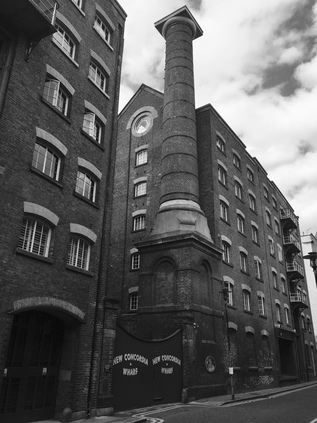
Just short of Tower Bridge I leave the path, skirting the Design Museum and heading inland to make a loop back to London Bridge station via the heart of Bermondsey's increasingly fashionable artisan district. The long tunnel under the fan of railway lines leads me to the edge of the redeveloped station site with its arches once bustling with industry now closed for redevelopment and relaunch as gentrified boutique units. A new-build business district flanks the station with glass-fronted chain eateries and bars. I wait for a bus, knowing that the Ride London cycle event is blocking the streets of the City, and that I have a long journey west ahead of me. My journey to Tower Bridge - an unofficial goal - was not quite completed in the end, but my walk along the river covered the ground I'd broadly hoped I'd manage. Turning back west for recent walks was not an easy decision in some ways, and using my limited visits to stray from the main centre of my interests was a gamble. But it has paid off - and I find myself intrigued and eager to explore more of these areas which again I've only skirted over by rail. As I idly gaze into the glass of the bus window I realise that my face is tender from the sun, my hair wild and sweat-drenched. I feel foolish here in the City, amidst the cyclists and their irritatingly healthy glow. It's time to head home.
You can find a gallery of images from the walk here.
Lost::MikeGTN
I've had a home on the web for more years than I care to remember, and a few kind souls persuade me it's worth persisting with keeping it updated. This current incarnation of the site is centred around the blog posts which began back in 1999 as 'the daylog' and continued through my travels and tribulations during the following years.
I don't get out and about nearly as much these days, but I do try to record significant events and trips for posterity. You may also have arrived here by following the trail to my former music blog Songs Heard On Fast Trains. That content is preserved here too.

